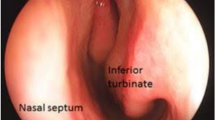Abstract
Inferior turbinate hypertrophy is one of the major causes of nasal airway obstruction. Medical treatment often produces insufficient improvement. In these cases, surgical reduction of inferior turbinate can be proposed. Many different techniques are currently available. The aim of our study is to prospectively evaluate the effectiveness of three techniques i.e., electrocautery, cryotherapy and radiofrequency by comparing the response of patients to these three surgical modalities of turbinate reduction. A total of 90 patients presenting with nasal obstruction with or without allergic symptoms, fulfilling the inclusion and exclusion criteria, attending ENT OPD are included in the study. A prospective study was conducted on three groups of thirty patients with symptoms and signs of nasal obstruction associated with inferior turbinate hypertrophy of more than 3 months duration. Then the percentage of subjective improvement in nasal airway is used to assess treatment outcomes 1week, 1, 3, 6, 9 and 12 months after surgery. At the end of 12 months, 56.6 % of patients treated with electrocautery and 56.6 % of patients treated with cryotherapy showed 75 % improvement in nasal obstruction whereas 59.99 % of patients treated with radiofrequency showed 100 % improvement. No statistical difference in the amount of improvement in nasal obstruction was noted between the three treatment groups at the end of 12 months because of relatively small sample size. But clinically radiofrequency showed better subjective improvement in nasal obstruction when compared to cryotherapy and electrocautery.
Similar content being viewed by others
References
Harrill WC, Pillsbury HC, McGuirt WF, Stewart MG (2007) Radiofrequency turbinate reduction: a nose evaluation. Laryngoscope 117:1912–1919
Gray LP (1978) Deviated nasal septum. Incidence and etiology. Ann Otol Rhinol Laryngol 87(suppl):3–20
Stewart MG, Witsell DL, Smith TL, Weaver EM, Yueh B, Hannley MT (2004) Development and validation of the nasal obstruction symptom evaluation (NOSE) scale. Otolaryngol head and neck surgery 130:157–163
Coste A, Yona L, Blumen M et al (2001) RF is a safe and effective treatment of TH. Laryngoscope 111:894–899
Meridth GM (1988) Surgical reduction of hypertrophied inferior turbinate: a comparison of electrofulguration and partial resection. Plast Reconstr Surg 81:891–897
Warwick-Brown NP, Marks NJ (1987) Turbinate surgery: how effective is it? A long term assessment. ORL J Otorhinolaryngol Relat Spec 49:314–320
Smith TL, Corea AJ, Kuo J, Reinisch L (1999) RF tissue ablation of inferior turbinates using a thermocouple feedback electrode. Laryngoscope 109:1760–1765
Freidman M, Janyer H, Lim J et al (1999) A safe, alternative technique for inferior turbinate reduction. Laryngoscope 109:1834–1837
Passali D, Passali FM, Damiani V et al (2003) Treatment of ITH: a randomized clinical trial. Ann Otolo Rhinol Laryngol 112:683–688
Dawes PJ (1987) The early complications of inferior turbinectomy laryngol Otol 101:1136–1139
Lin HC, Lin PW, Su CY, Chang HW (2003) Radiofrequency for the treatment of allergic rhinitis refractory to medical therapy. Laryngoscope 113:673–678
Author information
Authors and Affiliations
Corresponding author
Rights and permissions
About this article
Cite this article
Dhulipalla, S. Comparative Study of Response Through Reduction in the Size of Hypertrophied Inferior Turbinate Causing Nasal Obstruction by Different Surgical Modalities: A Prospective Study. Indian J Otolaryngol Head Neck Surg 67, 56–59 (2015). https://doi.org/10.1007/s12070-014-0772-9
Received:
Accepted:
Published:
Issue Date:
DOI: https://doi.org/10.1007/s12070-014-0772-9




